Citizen Public House
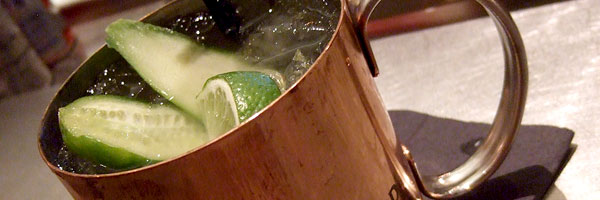 |
|
| Moe'scow Mule | Dominic Armato |
Okay, it's time to officially write the death certificate for the gastropub.
Not the institution, but the term. The patient was already terminal when it hit our shores, and the word is now stone dead, having been rendered completely meaningless by way of overuse. I'm sorry, I need to get this out of the way. Because the fact is that I like Citizen Public House. Quite a bit, actually. And I don't want this annoyance running through my head while writing about the food. Yes, some (some) of the dishes are rooted in bar food. But that aside, as far as I can tell, the only thing Citizen Public House has in common with London's gastropubs is that it serves food and drinks. It isn't warm, it isn't cozy, and it isn't the kind of place where you'd sit at a table with your pals drinking all night and maybe getting a bite to eat. It's cavernous, stark, dim and modern with white tablecloths and wine glasses on every table, and a stainless steel bar. And while its drinks are excellent, it isn't a drinking establishment at heart. Cover up the sign, talk to 100 patrons, ask them to describe the place as best they can and I doubt a single one utters the word "pub." It's a restaurant. A stylish Scottsdale restaurant with a strong beverage program. And there's nothing wrong with that! In their defense, the word "gastropub" never appears in any of their literature (at least not that I've seen), even if the implication behind the name and the description is clear. But what's important to take away here, aside from the fact that I really need to take a few deep breaths, is that Citizen Public House doesn't need to pretend it's something else to piggyback on the culinary zeitgeist. It doesn't have to be a concept. It can just be a restaurant. And it's a really good one.
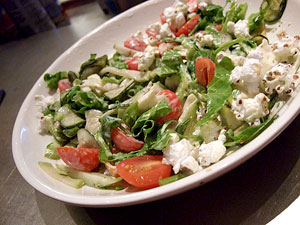 |
||
| Mirliton Chopped Salad | Dominic Armato | |
Bernie Kantak, having left clan Kasperski, has partnered up with Richie Moe and Andrew Fritz to open Citizen Public House, and he's brought a menu that uses casual American fare and bar food as touchstones. There are "bar snacks" like popcorn and mac and cheese, starters that apply atypical ingredients to typical forms, a handful of sandwiches, entrees that will look very familiar even if they aren't entirely, and lots and lots of bacon. Seriously, for better or worse, about a third of the items on the menu feature bacon. Over a few visits, I never quite got to the bar snacks, but I got a pretty good sampling of the rest of the menu, including an extremely smooth pisco sour and the Moe'scow Mule, mostly traditional but for a couple thick slabs of cucumber that turned into a cool and crisp booze-cured snack by the time I'd finished the drink. Kantak's brought along his chopped salad from Cowboy Ciao, but when seeking something vegetal, I went with the Mirliton Chopped Salad, with the eponymous mirliton (chayote), grape tomatoes, grilled halloumi, snow pea greens and popcorn. It's done with a creamy but very thin and light garlic dressing, and it's a very nice mix, even if it doesn't transcend the genre.
UPDATE : The original chopped salad does, in fact, transcend the genre... outstanding dish.
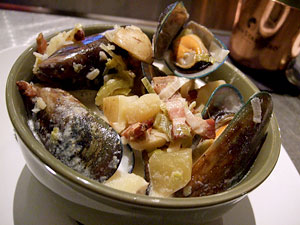 |
||
| Greenlip Mussel Chowder | Dominic Armato | |
More notable, I thought, was the Greenlip Mussel Chowder, served in a huge bowl piled with a cool dozen of the little aquatic beasts. I've always thought black mussels a tastier specimen than the monstrous, meaty greenlips, but I can find little else wrong with a dish that's making me miss our brief stint on the east coast. Though creamy, the chowder escapes the viscosity trap, staying thin and light enough that the richness doesn't become overpowering. Where countless bad chowders are glue, this remains soup. It's purposefully rough around the edges, with big chunks of vegetable and bacon strewn throughout. It's got the natural sweetness of good dairy, and though it isn't overpowering, enough of the bivalves' briny essence is worked into the soup to ensure that they remain the star. Downside? The plate was hot enough to cauterize flesh. But that's really just an excuse to use the word cauterize. It's a great dish.
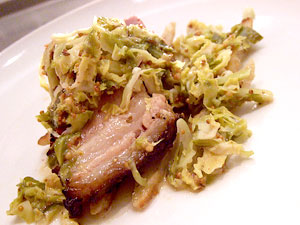 |
||
| Pork Belly Pastrami | Dominic Armato | |
Even better was the killer Pork Belly Pastrami. The pastrami connection, as far as I can tell, is limited to the spice that crusts the meat. This isn't pastrami with pork belly subbed in for brisket. But making a killer dish will always earn you a bit of latitude with the terminology, and this is no exception. It's some seriously lush pork, blackened and a little crisp on the edges, fatty bliss in the middle, and it's paired with a brussels sprout "sauerkraut" that, again, is kind of a misnomer because though potent it's rather clean and fresh and a crisp sweet-sour foil to the rich pork. Mustard seed plays a prominent role without getting belligerent, and fried spaetzle with rye seed adds a little chewy texture and an aromatic note that evokes the rye bread of your pastrami sandwich and ties the dish together. I really enjoyed this one a lot.
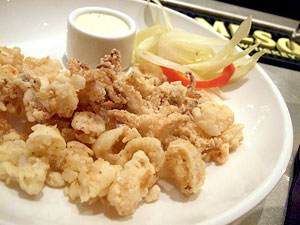 |
||
| Crispy Squid | Dominic Armato | |
The lone miss among the starters was one where my hopes got ahead of what my expectations probably should have been. Fried calamari broke its ethnic bonds a while ago and has become universal bar food, but with very rare exception it fails to capture the crisp succulence of Italy's fritti misti, instead presenting as nondescript fried nuggets to be dipped in lousy tomato sauce. I'd done well enough with some of the other starters that I hoped CPH's version would be a little more. And it was, but not enough. The lightly sweet and creamy lemon-anise tartar sauce and fennel pickles were very much appreciated as creative touches, but the squid was still lost in the batter, chewy and dry and barely recognizable as seafood. Which still makes it better than many plates of the same, but it was a disappointment, compared either to my hopes or to the rest of the menu.
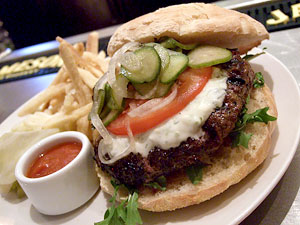 |
||
| Lamb Burger | Dominic Armato | |
Though the sandwich selections include a BLT, Wagyu burger (THANK YOU for not calling it Kobe, guys) and an interesting-sounding grilled halloumi, I couldn't get away from the lamb burger, and I'm glad I didn't try. Gussied up with tomato, pickled cucumber and onion and a light tzatziki, what made it was an absolutely beautiful patty, medium rare, moist, dripping with juice and screaming fresh lamb. Big, intense lamb flavor, accented by the condiments rather than dominated by them, and rivulets of lamb fat streaming down to your elbows is a recipe for success, as far as I'm concerned. Sitting on a bun with body and paired up with some pretty decent fresh fries and a house made ketchup, it's one of the best burgers I've had of any stripe in quite a while.
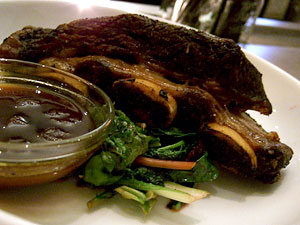 |
||
| Coffee Charred Short Ribs | Dominic Armato | |
The two entrees I tried were flawed, but close enough that it wouldn't stop me from getting them again. the Coffee Charred Short Ribs, flanken cut, put up a bit of a fight, and I mean that as a compliment. They were tender, to be sure, but they hadn't been stewed to death, possessing not only just a little bit of satisfying chew, but a crisp, smoky bark that gave it even more textural interest. Plated with a simple but tasty roasted parsnip puree and an assortment of sautéed green vegetables, the problem was with the sauce. Billed as a "dried cherry BBQ sauce," the flavor was on, but there was much, much, much too much of it. It was absurdly sweet, almost candylike, and the only thing that kept it from being completely unpalatable was a certain amount of balancing sourness which took it from inedibly sweet to way too sweet and sour. "I was tasting it an hour later" is a tired piece of critical hyperbole, but here it wasn't hyperbole. An hour later, I couldn't get that sticky sweetness out of my mouth. Its most redeeming quality was that it was wisely served on the side, to allow for careful application. And it's a shame, because the quality of the flavor was right on. It was just way too intense. But everything else on the plate was delicious, and just a little reworking of that sauce would make it a great dish.
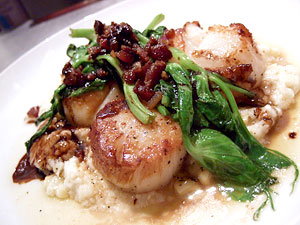 |
||
| Pan Seared Scallop | Dominic Armato | |
The pan seared scallops suffered the opposite fate. Served atop grits with "lardons," snow pea greens and a red rock cola gastrique, it could be more aptly described as scallops with butter. If there was less than three ounces of butter on the plate, I'll turn in my (non-existent) credentials. But I have no issue with an abundance of butter. This was not the problem. Nor were the grits, which were creamy and studded with kernels of fresh corn, nor the greens which were wilted but retained their fresh flavor, nor the lardons which... well, they ended up coming across less like lardons and more like bacon bits, but even this wasn't a problem since they added a little bit of crisp texture. The problem was simply in the cola gastrique. Or, more accurately, the problem was in the absence thereof. The scallops were so incredibly rich, saturated with butter and bacon, that they needed the gastrique's acidity to keep them from crushing you under their weight. The few bites I had with the gastrique were fabulous. But there was only enough gastrique for a few bites. It either needed to tone down the richness, or bring on the gastrique. I vote the latter. But again, I still rather enjoyed the dish despite this issue, and those few fully-composed bites were dynamite.
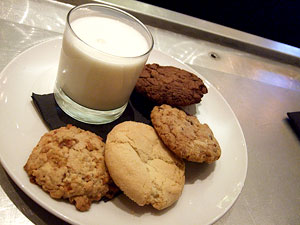 |
||
| Cookies & Milk | Dominic Armato | |
Desserts, done by Tracy Dempsey, are pretty straightforward, and the first I tried was the most straightforward of all, the milk and cookies. What you see here was my artful arrangement to allow you to actually see the cookies. In reality, they arrived at the table like this, a sealed bag unceremoniously set on the plate next to a glass of milk. Sporting such specimens as spicy chocolate fudge and an oatmeal variant involving fruit and bacon, I enjoyed the cookies, but was a little put off by the presentation. Not because I thought it indelicate. I actually kind of liked the humor of it. But gosh, it sure would have been nice if the cookies had been warmed, maybe... anything to separate it from something you might just pick up off the store shelf.
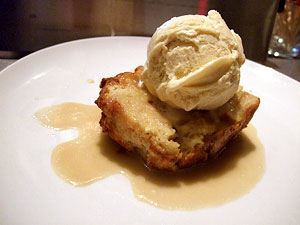 |
||
| "Pig in the Orchard" | Dominic Armato | |
Bread pudding was much more successful, titled "Pig in the Orchard" for the combination of apples and bacon therein. So yes, both of my desserts featured bacon. And while bacon works great in a dessert context, I really hope we're getting past the "Ooooh, bacon dessert!" phase of the bacon craze so we can enjoy it with just a little less ubiquity. In any case, it was a nice bread pudding, a little cakey and not quite as moist as I'd like, but very tasty, with cinnamon ice cream, an intensely sweet bourbon brown sugar sauce, chunks of tender apples and the aforementioned bacon, crusted on top, which was subtle enough that it could almost slip by unnoticed. It hit a nice balance of sweet and savory, nailed a la mode's always successful warm and cold contrast, and made me happy, if a little overstuffed. But there, I can only blame myself.
So pub pedantry aside, I hope it's clear that I think this is a very good restaurant. And to reiterate, my annoyance with the misnomer that the American gastropub has become doesn't extend to the restaurant itself for a moment. I've enjoyed almost every plate I've had at Citizen Public House, and some of them I've loved. And I like the restaurant for what it is. It doesn't have to be warm and chummy and smelling of stale beer. The food doesn't have to be limited to slightly elevated classics. You don't have to risk catching a dart in the neck when you get up to use the restroom. Don't misunderstand, Kantak is trying to walk a fine line between familiar and contemporary here, and he does so with aplomb. But Citizen Public House doesn't have to be sold as a public house to succeed. It'll do that because it's a great place to eat and drink. And it'll be that no matter what they call it.
| Citizen Public House | |
| www.citizenpublichouse.com | |
| 7111 E. 5th Avenue, Suite E | |
| Scottsdale, AZ 85251 | |
| 480-398-4208 | |
| Mon - Sat | 11:00 AM - 11:00 PM |
| Sun | 5:00 PM - 11:00 PM |

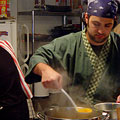
I have a very happy memory of spending a week in the Cotswolds - Chipping-Camden was the name of the town, I believe. Every afternoon I would go to a pub (it was the week between Christmas and New Years and the area was covered in snow) and sit by the fireplace drinking Scrumpy Jack and having the game pie du jour while reading a good book. I would spend hours every day and it was marvelous. When I go to England now, so many of the pubs have become gastropubs serving all kinds of trendy foods usually done poorly. No more game pies, fish and chips or bangers and mash. I miss the old style pub.
Posted by: Danny | March 24, 2011 at 04:24 AM
I'm curious - why is Wagyu the correct term and not Kobe? Does Kobe technically only refer to beef from Kobe, Japan?
Also, I'm a long-time lurker, first-time commenter, so just wanted to say thank you for your excellent writing, regarding Top Chef and otherwise.
Posted by: natalia | March 24, 2011 at 12:07 PM
Wagyu is the breed of cow, and Kobe is a particular type of Wagyu from that region.
I remain skeptical as to the benefits of a Wagyu hamburger. The main purpose to grinding beef in the first place was to make use of extremely tough, but flavorful, cuts of beef that would otherwise be largely inedible. When you grind wagyu, you lose all of that beautiful marbling which characterizes that beef. Yes, you've got to do something with all those gristly neck shoulder cuts on a wagyu, but I question how superior a wagyu burger would be to a regular, grass-fed Angus or Texas longhorn.
Posted by: Independent George | March 24, 2011 at 01:00 PM
IG's on point. It's more than just a combination of breed and region, though. Like other premiere regional foodstuffs, the producers are heavily invested in the quality the name denotes, so they're produced to absurd standards. When you're talking marbling, for example, USDA grades top out at Prime, which roughly approximates A5 on the Japanese scale that goes from A3 to A12. There's Kobe out there that looks like it's more fat than meat. It might be. And it's so vastly different that it's almost like a different animal. A10 : Prime :: Foie Gras : Chicken Livers.
The Wagyu bred domestically sometimes captures some of that Kobe succulence, but I've never seen anything in the States even remotely approaching the stuff from Japan. Part of the reason is that much if not most (I'm unfamiliar with the exact statistics) of what's bred here isn't pure Wagyu, but rather a Wagyu-Angus hybrid... Wangus, if you will. Some of the stuff sold as Wagyu had one Wagyu steer somewhere five generations back in the bloodline, so there's a lot of room for false advertising there as well.
What makes it a particularly egregious sin is that Japanese beef imports are banned at the moment, and have been since, I believe, April 2010. So it isn't even possible to get Kobe in the States right now. Not that you couldn't immediately spot the falsehood from the price tag, anyway. By the time it's shipped overseas, Kobe beef usually costs in excess of $100 per pound. Sometimes much, much more.
So when I see a $15 Kobe burger on a menu, I immediately know that restaurant management is either highly dishonest, or shamefully ignorant of their product. Neither speaks well of them.
Posted by: Skillet Doux | March 24, 2011 at 01:20 PM
To further Dom's point, I believe in Japan they actually keep geneologies of individual cows and spend pretty serious sums on getting the best breedings, to say nothing of the infamous stories of feeding the cows Guinness and regular neck massages. Think of it as the marriage of French AOC appellations with Japanese engineering.
You know what, that's actually kind of scary, now that i think of it.
Posted by: Independent George | March 24, 2011 at 02:11 PM
@skilletdoux and @IG: Thanks for your responses! I've heard tales of cow massages, but had no idea that the actual standards and grades are so vastly different in Japan and the US. Really good to know.
I hope that "Wangus" enters restaurant vernacular as soon as possible.
Posted by: natalia | March 24, 2011 at 03:50 PM
Wangus would be an excellent name for a band.
Posted by: pepperjack | March 25, 2011 at 08:02 AM
Pepperjack... Wangus also happens to be the screen name of a regular commenter here, though I have no idea if he reached his nick by the same means. Wangus?
Posted by: Skillet Doux | March 25, 2011 at 08:44 AM
Good post. Re: Gastropub; PUBlic: I think the term Gasthaus deserves better currency by restaurateurs in USA. Gasthaus fits best, being a true hybrid of good food/good drink with no aspersions cast at the next table. The Japanese do this style well, too, but I don't know the term for that establishment.
Also @ CPH menu: naming conventions funnies:
"Bud Light, St. Louis, MO"
Posted by: bryanD | March 25, 2011 at 07:46 PM
Dom - next time you are back in Chicago, check out Longman & Eagle. It might restore your faith in the gastropub.
During prime dining hours, the demand is so high that it's not a place that you can hang out for a drink easily. But later in the evening, once the suburbanites and lincoln parkers have headed back home, it is a great time to work through the extensive wisky list.
Posted by: Kat | March 28, 2011 at 10:10 AM
Kat... like I say, it's not the institution, it's the name. It's one of those culinary buzzwords that's been watered down to the point of being completely useless. Longman & Eagle may actually be one... we almost went on our last trip and didn't quite get there. But whether or not L&E is one of the offenders, it's time to put the term to bed except in the strictest, most accurate sense.
Posted by: Skillet Doux | March 28, 2011 at 10:19 AM
Omg, I didn't know I could get a lamb burger in this town. I'm there!
Posted by: gwynne | April 30, 2011 at 08:50 AM